by N. Striegel, R. Ellis, J. Deering 1 (3/09)
Quick Facts…
- A protozoan organism, Trichomonas foetus (Tritrichomonas foetus), is the etiological cause of the disease. The disease itself is called trichomoniasis.
- The primary mode of transmission is from sexual contact during the act of a bull breeding a cow.
- No one knows if a herd is free from the infection until it is tested.
- Four most important risk factors:
- Bull exposure from neighboring pastures/herds
- Cows commingling with neighboring pastures/herds
- New bull additions without testing (non-tested bulls)
- Retaining open cows into the next breeding season
Trichomoniasis (Trich.) infection of cattle is a devastating disease for cattle producers. When diagnosed in a herd, it causes economic loss and emotional pain. “Trich is no treat!” There is no treatment for Trichomoniasis infection. This discussion focuses on prevention. The foundation of building a prevention program for your herd is testing all the bulls that will have exposure to your cows.
In today’s world of ever increasing input costs, producers are looking for ways to cut expenses. The following information will not only encourage beef producers to continue testing for Trichomoniasis, but will also encourage those who do not test to include it in their herd health management program.
Background
A protozoan organism, Trichomonas foetus (Tritrichomonas foetus), is the etiological cause of trichomoniasis. This organism lives in the reproductive tract of the cow and in the sheath of the bull’s penis. The primary mode of transmission is from sexual contact during the act of a bull breeding a cow. When a cow becomes infected, the following can happen.
- Trichomonas foetus infection can cause the cow to be infertile and she continues to cycle until she builds up immunity. (Immunity is usually short-lived and the cow can become re-infected.)
- The cow can become pregnant but then early in the pregnancy, she aborts and comes back into heat.
- The cow can carry the fetus to full term, can remain infected, and shed the infective Trichomoniasis protozoan after calving.
Most often, the first clinical sign of trichomoniasis in a herd is an increased percentage of open cows or “late” cows at the fall pregnancy check. If fall pregnancy checking is not done, clinical signs in the herd are reduced calving rate and a calf crop that is strung out over three to six months.
Bulls will show no signs of the disease but can shed the organism indefinitely. To diagnose the disease, a preputial fluid sample is taken from the sheath of the bull’s penis. The preputial sample is sent to a veterinary diagnostic lab where a culture or a PCR test is performed. Once a diagnosis of trichomoniasis is made in a herd, control and prevention of future infections involves culling the infected bulls and retesting any negative bulls until three negative tests are obtained.
- bull exposure from neighboring pastures/herds;
- cows commingling with neighboring pastures/herds;
- new bull additions without testing (non-tested bulls); and
- retaining open cows into the next breeding season.
Veterinarian Survey
In 2008, a twenty-seven question survey was sent to Colorado veterinarians in bovine practice
to gain insight on Trichomoniasis in Colorado cattle herds and to determine the median veterinary costs of herd testing bulls for Trichomoniasis. The survey took place from May to August of 2008. These veterinary fees were then extrapolated to develop “cost per cow” figures.
There were twenty-four different Colorado veterinary practices represented in the survey. Respondents were located in all four quadrants of the state. Sixty-eight percent of the responding veterinarians spend between 25 to 75 percent of their practice time on beef cattle. Seventy-one percent of the veterinarians said that the majority of the producers in their practice have herds of 150 to 300+ cows.
The information was compiled based on four different bull-testing scenarios.
- Scenario 1: The total veterinary fees for Trich testing bulls (including lab fees and farm visit fee) on a ranch 10 miles from the veterinary clinic.
- Scenario 2: The total veterinary fees for Trich testing bulls (including lab fees and farm visit fee) on a ranch 75 miles
from the veterinary clinic. - Scenario 3: The total veterinary fees for Trich testing bulls that are hauled to a veterinary clinic (including lab fees).
- Scenario 4: Performing Bull Breeding Soundness Exam (BBSE) at the same time as Trich testing.
In addition to the four scenarios above, veterinarians were asked for their fee structure for testing a “bull battery” consisting of:
- two bulls tested,
- five bulls tested,
- 10 bulls tested,
- 15 bulls tested.
Through this survey, valuable information on veterinary fees for Trich testing and Bull Breeding Soundness Exams (BBSE) was gathered. Converting the collected fee information to a “cost per cow” figure shows the true value of Trichomoniasis testing and prevention.
Assumptions
For the following graphs and charts, a bull-to-cow ration of one bull per 20 cows has been used. The literature reveals various recommendations on bull to cow ratios. Many producers apply different ratios to their herd situation but we did not want to overstate the value of testing by using a high bull-to-cow ratio. By using the figure of 1:20, the “number of bulls tested” parameter (Test 2 Bulls, Test 5 Bulls, Test 10 Bulls, and Test 15 bulls) reflects cowherds of 40, 100, 200, and 300, respectively.
Scenario 1. Trich Testing and 10 Mile Farm Call:
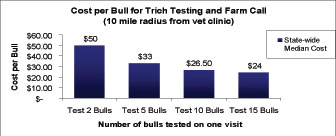
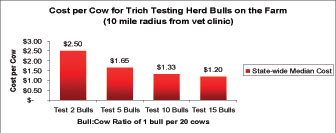
Scenario 2: Trich Testing and 75 mile Farm Call:
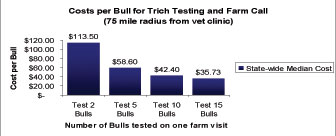
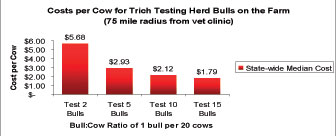
Scenario 3: Trich Testing “In-Clinic”:
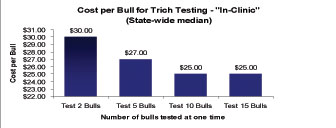

Scenario 4: Performing BBSE at same time as Trich testing:
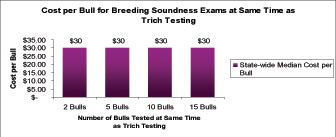
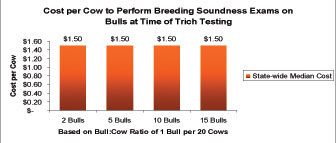
| Cost per Cow Chart | |||
|
40-Cow herd
|
10 mi. Farm Call
|
75 mil Farm Call
|
“In-Clinic”
|
| Median Cost per Cow for Trich Testing |
$2.50
|
$5.68
|
$1.50
|
| Median Cost per Cos for Breeding Soundness Exam |
$1.50
|
$1.50
|
$1.50
|
|
100-Cow herd
|
10 mi. Farm Call
|
75 mi. Farm Call
|
“In-Clinic”
|
| Median Cost per Cow for Trich Testing |
$1.65
|
$2.93
|
$1.35
|
| Median Cost per Cow for Breeding Soundness Exam |
$1.50
|
$1.50
|
$1.50
|
|
200-Cow herd
|
10 mi. Farm Call
|
75 mi. Farm Call
|
“Im-Clinic”
|
| Median Cost per Cow for Trich Testing |
$1.33
|
$2.12
|
$1.25
|
| Median Cost per Cow for Breeding Soundness Exam |
$1.50
|
$1.50
|
$1.50
|
|
300-Cow herd
|
10 mi. Farm Call
|
75 mi. Farm Call
|
“In-Clinic”
|
| Median Cost per Cow for Trich Testing |
$1.20
|
$1.79
|
$1.25
|
| Median Cost per Cow for Breeding Soundness Exam |
$1.50
|
$1.50
|
$1.50
|
The cost per cow figures do not take into account any artificial insemination (AI) programs within the herd. Incorporation of AI into the reproductive program of the herd will decrease the bull-to-cow ratio, decrease the number of bulls to test, and decrease the total costs of testing for the herd. In that case, the total cost of testing the bull battery would have to be divided by the
total number of cows in the herd to determine a cost-per-cow figure. Of course, if only AI is used in the herd and there are no “clean-up” bulls utilized, there would be no bulls and no herd costs for Trich testing.
By computing the cost per cow, the value of Trich testing and Breeding Soundness Exams is revealed for the beef herd. A producer that has a 100-cow herd, uses one bull per 20 cows, and lives 75 miles from a veterinary clinic will incur $2.93 per cow to test all of the herd bulls for Trich. It will only cost another $1.50 per cow to perform a Breeding Soundness Exam on the herd bulls to find any bulls that are “infertile” or “sub-fertile.” The total cost is $4.43 per cow for Trich testing and Breeding Sound Exams. The Cost per Cow Chart shown above demonstrates that the cost per cow would be lower for a larger herd or if the producer lives closer to the veterinary clinic or if the bulls can be hauled in for “in-clinic” testing.
This cost per cow is a bargain considering the lost opportunity of having a pregnant cow ready to calve within a pre-determined calving season. In short, performing breeding soundness exams and Trich testing before the breeding season is inexpensive insurance against a disease outbreak and/or a breeding season disaster due to low calving rates.
1Colorado State University Extension agent – Boulder County and Golden Plains Area; assistant professor, bovine reproduction, College of Veterinary Medicine and Biomedical Sciences; and Golden Plains Area agent, Colorado State University Extension. 3/09.
Colorado State University, U.S. Department of Agriculture and Colorado counties cooperating. Extension programs are available to all without discrimination. No endorsement of products mentioned is intended nor is criticism implied of products not mentioned.
Go to top of this page.





